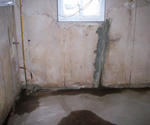For decades, thousands of satisfied homeowners have relied on The B-Dry System to solve their wet basement problems.
For more information, immediate assistance or a free estimate, select one of the options below.

Wall Crack Leaks - Form Pin Leakage
Wall Crack Leakage - A basement wall crack that's visible from inside the basement means that the wall is cracked clear through to the outside. When basement walls crack, so does the outside sealing materials and original waterproof coating.
Concrete Form-Pin Leaks - Form-pins in poured concrete walls are visible pieces of steel rods left over from the original construction process. The form-pins were used during construction to hold the concrete forms in place while the basement walls cured. Because it's impossible to remove these leaky pins, the builder will usually apply an outside waterproof sealing compound outside to prevent them from leaking. As time goes by, the form pins begin to rust away and allows water to enter.
Methods for Sealing Basement Walls:
Excavation: If the affected areas are not too deep underground, you can hand dig the soil outside the affected areas. Check with your local building officials to see what bracing requirements are needed to keep the trench from collapsing around you. Generally, if you have to dig more than two or three feet deep, hire a professional who has the proper safety equipment.
Clean and prepare the foundation walls by scraping and brushing off loose dirt and deteriorated coatings. Pressure washing is probably not a good idea because the mud created will further contaminate the walls or even block the footer drains below.
Apply a liquid waterproof sealing compound with elastomeric properties that can withstand future movement or expansion and contraction of the basement walls. Read the manufacturer's application instructions carefully.
Alternatively, you can apply a waterproof sheet membrane to the outside wall. These rubberized membranes come in roll form and can usually be purchased at a professional roofing supply outlet. Be sure to purchase the manufacturer's liquid primer which must be applied prior to the membrane installation.
Basically, you'll unroll a piece of membrane material long enough to cover and overlap the area you want to waterproof. There is a peel-and-stick backing that must be removed first. Have someone help you at this point because the membrane is extremely sticky and is almost impossible to pull off if it sticks to the wrong area.
After the outside waterproofing materials dry, start backfilling the soil three inches deep at a time. HAND TAMP ONLY. A power tamper can cause new cracks in your walls causing further damage. Fill in and tamp three inch deep layers, one at a time, and continue until the area is filled in. Add extra soil if needed to make sure that the finished surface is graded away from the foundation to keep surface water from collecting.
Crack Injection: Another method of sealing cracks in basement walls can be done from inside the basement. Holes can be drilled into the basement wall cracks and urethane grout can be pumped in, under pressure, to either seal the crack itself or to seal it off from outside the wall. If urethane grout is pumped completely through the wall and outside into the soil, it will expand to seal the cracks from the outside. A word of caution though: rocks, roots and other obstructions in the soil can prevent the grout from reaching every area and thus this method may not be 100% effective. While you will probably need a professional for this type of repair, it can be a reliable method for single, isolated areas that leak.
Interior Drainage & Rigid Sealers: Another approach to repairing basement wall leaks is to relieve the hydrostatic water pressure inside and seal the cracks with a rigid sealing material. This method consists of installing an interior drain tile system along the inside footer to relieve the water pressure. A panelized, waterproof, rigid wall sealer is then applied to the interior walls, all the way down to footer level. You'll want to select a sealer which is capable of expansion and contraction while bridging wall cracks or pin-holes.
Hydraulic Cement & Liquid Sealers: There are products available in liquid or powder form to seal wall cracks from inside your basement. These products come either ready-to-use or must be mixed with water before application.
Liquid sealers can penetrate the porous surface of the masonry and attach to the capillaries. Hydraulic cement products are used to repair basement wall cracks. Generally, you'll want to widen the crack, using a cold chisel, to give the material a larger and deeper area to adhere to. Hydraulic cement actually expands as it dries to fill cracks in cement walls or floors.
Both liquid sealers and hydraulic cement are easy do-it-yourself materials to use. The only downfall to these type applications is that they can only treat the surface area. Cracks will usually go completely through the wall and are almost impossible to completely fill with these materials. Also, expansion and contraction of the foundation over the changing seasons can cause these products to crack or loosen.
Regardless of which method you choose, carefully check any warranties to assure they cover the type problem you are having.
© 2017 B-Dry Owner's Association
RECOMMEND THIS PAGE